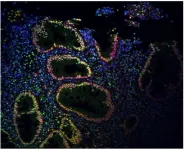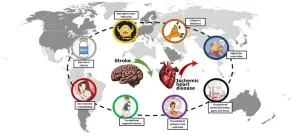Megapixel fluorescence microscopy through scattering layers made simple
2024-11-20
(Press-News.org)
A team from The Hebrew University of Jerusalem has introduced a new method for megapixel-scale fluorescence microscopy through complex scattering media. This approach resolves high-resolution images from several tens of widefield fluorescence-microscope frames without requiring specialized equipment such as spatial-light modulators or intensive computational processing. By efficiently correcting distortions caused by light scattering, the technique allows for clear imaging of dense and challenging targets. Its compatibility with conventional microscopy setups, coupled with the use of established matrix-based techniques, makes it practical for widespread use.
A recent study published in Science Advances, led by PhD student Gil Weinberg, MSc student Elad Sunray, and Prof. Ori Katz from the Institute of Applied Physics at The Hebrew University of Jerusalem, introduces a new approach to fluorescence imaging. This innovative method overcomes the detrimental effects of extreme light scattering in conventional fluorescence microscopy—one of the most crucial imaging techniques in life sciences. Supported by the European Research Council funding, the study unveils a high-resolution imaging technique capable of resolving complex scattering media, with promising applications in biological research, materials science, and beyond.
Random light scattering within or through dense and complex samples often hinders fluorescence imaging, leading to significant image distortion. While noninvasive coherent imaging through complex media has progressed in recent years, fluorescence imaging has remained limited by requirements for sparse targets, complex wavefront controls, or large data sets.
The researchers demonstrate megapixel-scale image reconstruction with fewer than 150 widefield fluorescence-microscope frames acquired under unknown random changing illuminations, all without using spatial light modulators (SLMs) or intensive computational resources. Its memory-efficient implementation drastically reduces computational demands, enabling the imaging of large and intricate samples. Unlike previous approaches, this technique does not depend on assumptions about object sparsity or requires managing low-order wavefront distortions.
Central to the approach is the construction of a 'virtual fluorescence-based reflection matrix,' an analog to the well-studied coherent reflection matrix in optics and ultrasound imaging, using a limited number of randomly illuminated frames. Once this mathematical equivalence is formulated, any of the well-established, powerful computational scattering-compensation techniques developed for coherent imaging can be applied to incoherent fluorescence imaging.
This advancement improves biological research, enabling clearer visualization of structures within dense tissues. Its compatibility with conventional microscopy setups enhances accessibility for both academic and industrial researchers, contributing to progress in optical imaging and providing new possibilities for exploring complex systems.
END
ELSE PRESS RELEASES FROM THIS DATE:
2024-11-20
People with chronic liver disease can be categorized into four distinct risk groups based on the different barriers they face in obtaining outpatient care, barriers that increase their odds of requiring hospitalization, a new UCLA study finds.
The findings, to be published November 20 in the peer-reviewed PLOS ONE, point to the need for interventions aimed at reducing possibly avoidable hospitalizations among the highest-risk people with chronic liver disease (CLD). Previous research has found that people with CLD on average need more hospital-based care than those with other chronic diseases.
About ...
2024-11-20
Have you ever wondered why an airplane has a vertical tailfin? The plane needs it to stabilize its flight. Since flying without a vertical tail is much more energy-efficient, the aviation industry has worked hard to accomplish this – so far without much success. However, birds don’t need a vertical fin, which raises the question: how do they do it?
David Lentink, Professor of Biomimetics at the University of Groningen, has developed a robotic bird model with real pigeon feathers to show how they do it. In previous work, he found that birds continuously ...
2024-11-20
Individual motivation to act against climate change outweighs the impact of hyperlocal collective intentions, though both approaches are worth strengthening, according to a survey of nine European neighborhoods published Nov. 20, 2024 in the open-access journal PLOS Climate by Christian A. Klöckner from the Norwegian University of Science and Technology and colleagues.
Western society contests the individual versus collective responsibility to combat climate change. But do people feel more motivated to act individually (e.g., making waste-free purchasing choices) or in tandem with others (e.g., protesting or completing ...
2024-11-20
Mental health issues are "prevalent and troubling" among forcibly displaced children and young people, per scoping review which finds PTSD, anxiety and depression to be most common conditions.
+++++
Article URL: https://journals.plos.org/mentalhealth/article?id=10.1371/journal.pmen.0000076
Article Title: Mental health issues of children and young people displaced by conflict: A scoping review
Author Countries: Nigeria, United States
Funding: The authors received no specific funding for this work. END ...
2024-11-20
Researchers at Duke University School of Medicine have found that tapping into the nervous system could help reduce the gut inflammation that drives inflammatory bowel disease (IBD).
A new study led by Luis Ulloa, PhD, and Wei Yang, PhD, reveals how electrical stimulation of the vagus nerve—a major nerve connecting the brain and gut—may combat the stress-related inflammation that worsens IBD symptoms.
Published in Science Translational Medicine, the study showed that vagus nerve stimulation in stressed mice with colitis, a form of IBD, reduced inflammation, improved symptoms, ...
2024-11-20
Incidence of stroke and ischemic heart disease are declining around the world, except for in a handful of regions, according to research in the open access journal PLOS Global Public Health. Wanghong Xu of Fudan University and colleagues find that in East and West Sub-Saharan Africa, East and Central Asia and Oceania, ischemic heart disease is increasing, which may be attributed to eight factors that include diet, high BMI, household air pollution and more.
Cardiovascular disease is a leading cause of death and disability worldwide, and ischemic heart disease and stroke ...
2024-11-20
Historical policies shaping educational attainment have enduring benefits for later life memory and risk of dementia, according to a study led by a Rutgers Health researcher.
The study, published in Epidemiology, compared the differences in years of education based on variations in state schooling mandates with cognitive performance outcomes in residents decades later.
“Policies to increase the quantity or quality of schooling now are likely to have long-term benefits on cognitive outcomes,” ...
2024-11-20
AMES, Iowa – Over the typical two-year rotation of corn and soybeans most Iowa farmers use, 40% of nitrous oxide emissions are in the soybean year, according to a new study by an Iowa State University research team.
The share of the potent greenhouse gas released during the soybean half of a crop rotation cycle is surprisingly high, given most soybeans fields aren’t treated with nitrogen, said Michael Castellano, agronomy professor and William T. Frankenberger Professor of Soil Science at Iowa State University.
“We’ve just been assuming that legume crops like soybeans don’t have a big emissions footprint because they don’t ...
2024-11-20
The California Institute for Regenerative Medicine (CIRM), the state’s stem cell agency, has awarded a two-year, $6 million grant to a team at the USC Dr. Allen and Charlotte Ginsburg Institute for Biomedical Therapeutics and the USC Roski Eye Institute advancing a new treatment for one of the leading causes of blindness in older adults. The funding will enable the researchers to conduct preclinical studies needed before launching human trials.
The investigators aim to accelerate progress in fighting dry age-related macular degeneration (AMD), which affects ...
2024-11-20
University of Delaware researchers have developed a method for mitigating the decontamination that tires release into the environment at the end of their lifespan.
In a new study published in Nature Chemical Engineering, the team demonstrated a way to upgrade 6PPD – a molecule that provides UV protection to help the rubber found in tires last longer – into safe chemicals. The method would also turn the leftover crumb rubber into aromatics and carbon black, a soot-like material found in everything from pigments to cosmetics to electronics. ...
LAST 30 PRESS RELEASES:
[Press-News.org] Megapixel fluorescence microscopy through scattering layers made simple



